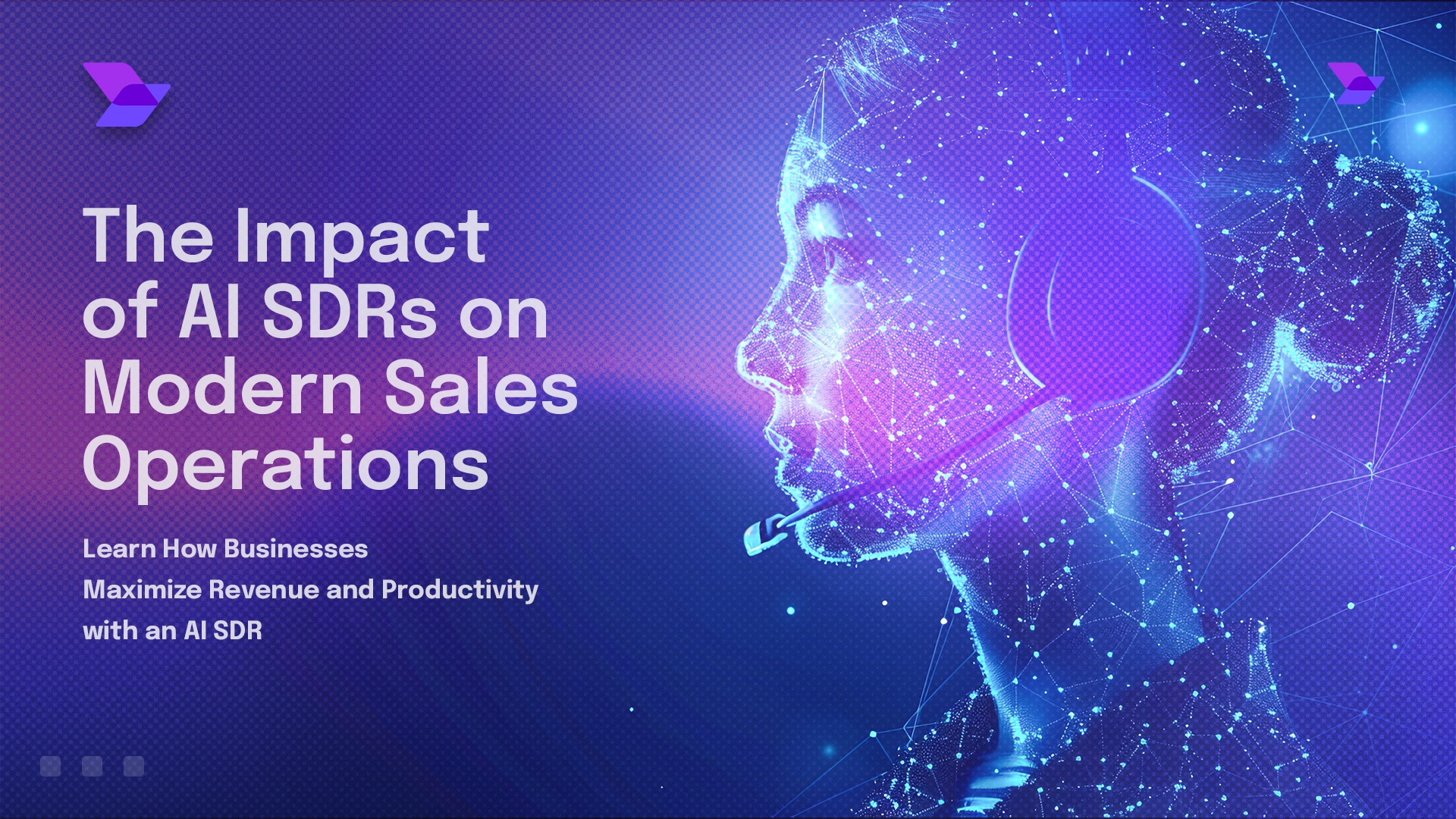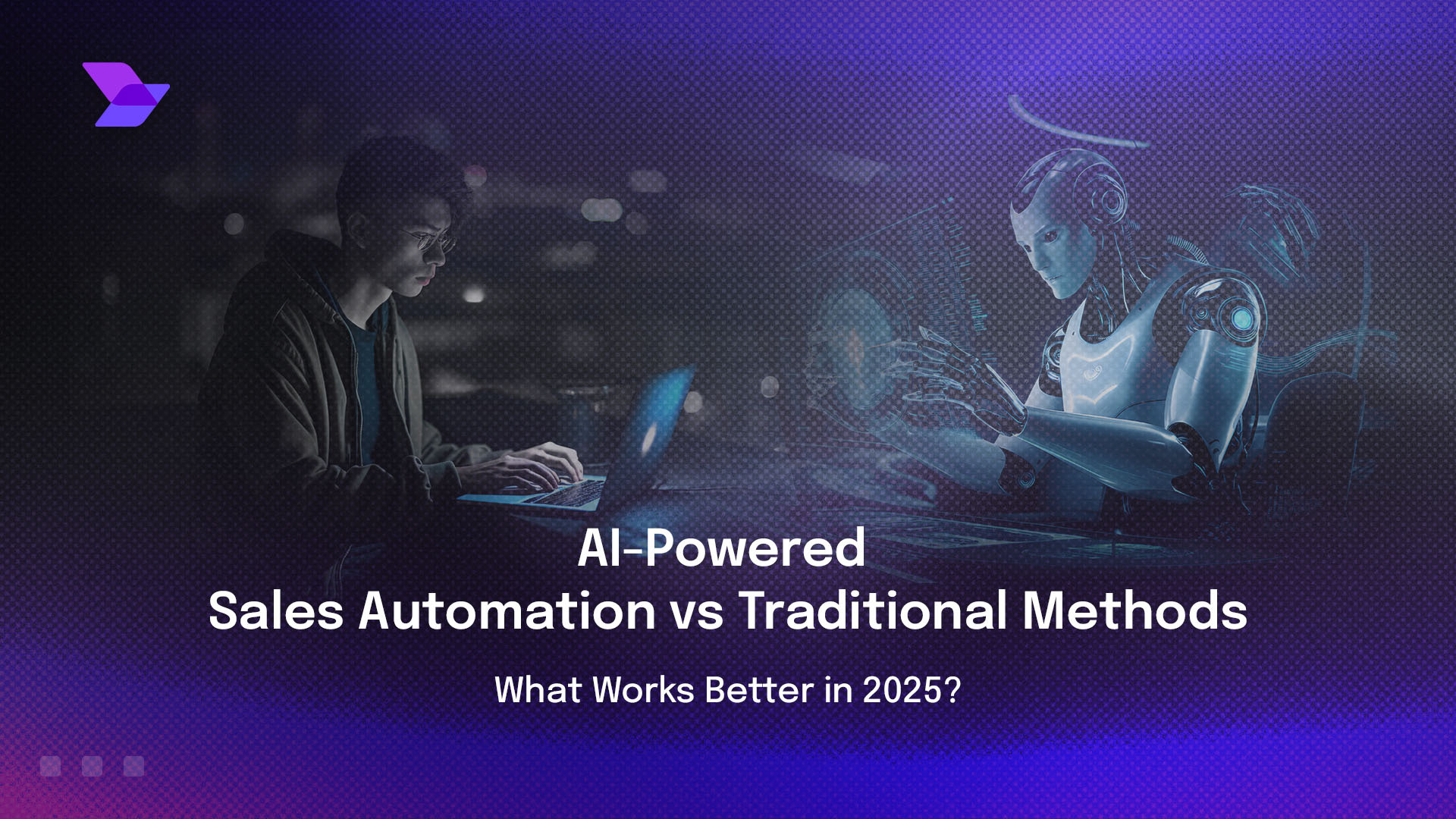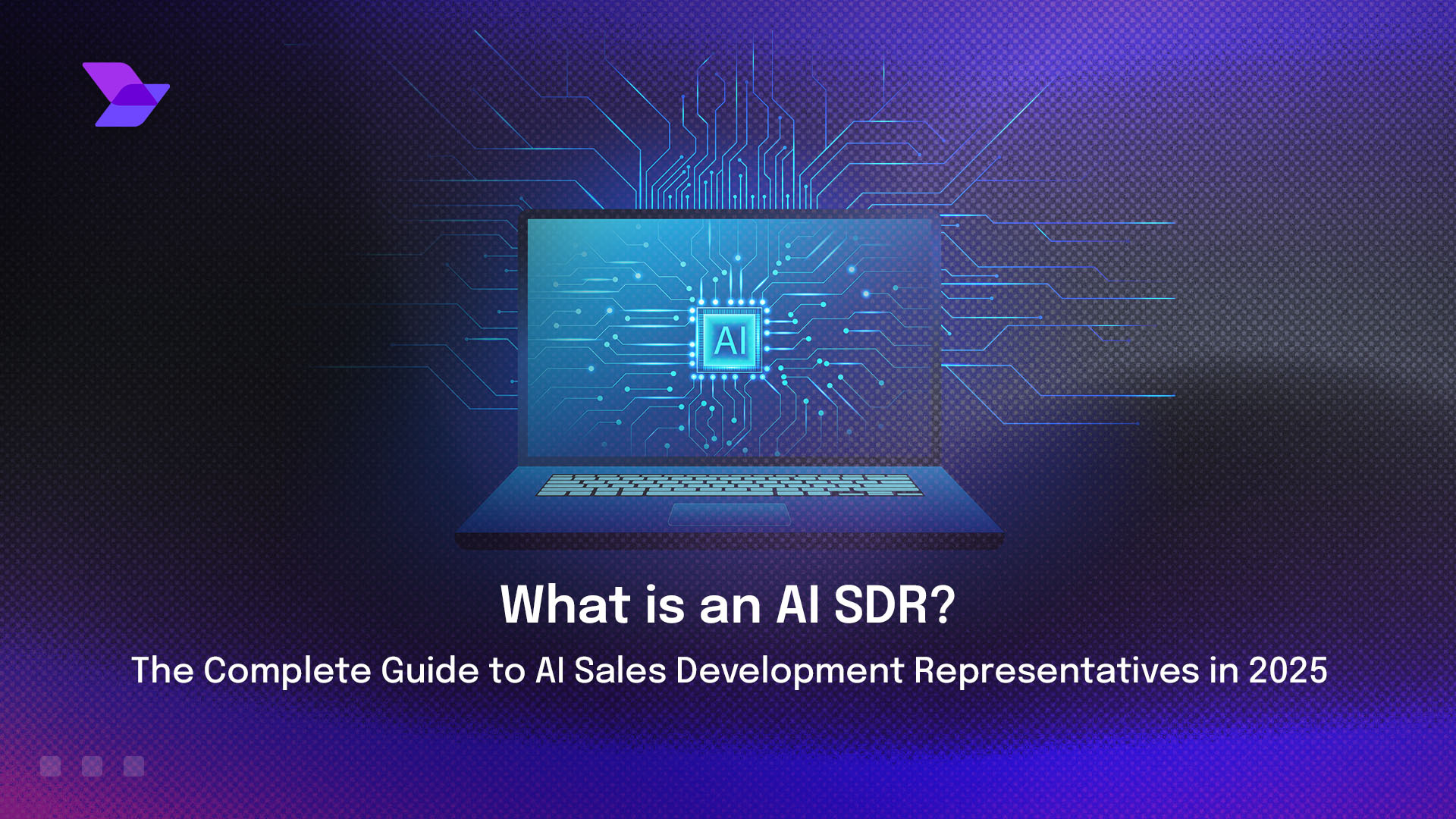Table Of Contents
Category
AIML
AI SDR
AI Sales Development Representatives (SDRs) are revolutionizing modern sales operations by leveraging machine learning algorithms for intelligent lead qualification, natural language processing for personalized outreach, and 24/7 automated engagement systems that operate across global time zones. These intelligent systems transform traditional manual processes into data-driven operations that can simultaneously manage thousands of conversations, improve lead conversion rates by up to 25%, and enable human sales teams to focus on high-value relationship building while maintaining consistent, personalized prospect interactions around the clock.
1. The Silent Revolution in Sales in 2025
The sales landscape of 2025 is witnessing an unprecedented transformation as AI SDRs evolve from simple automation tools into sophisticated systems capable of predictive analytics and autonomous decision-making. Companies implementing AI-powered lead scoring are experiencing conversion rate improvements of up to 25%, while SDRs utilizing these technologies are 2.5 times more likely to meet their quotas compared to traditional approaches. This revolution extends beyond basic qualification into advanced behavioral scoring and intent signal analysis, where AI systems process real-time data through machine learning algorithms to predict lead conversion likelihood with remarkable precision.
The most significant shift involves the emergence of conversational intelligence and autonomous qualification systems that operate with minimal human intervention. Modern AI SDRs now leverage advanced natural language processing to engage in meaningful conversations, understand context, and make intelligent qualification decisions while analyzing prospect behavior patterns and buying signals across multiple touchpoints. These systems are fundamentally changing resource allocation strategies, with research indicating that AI-powered lead scoring reduces qualification time by up to 30%, allowing sales organizations to redirect human talent toward high-value relationship building while maintaining scalable, data-driven prospect engagement.
2. What Exactly is an AI SDR?
An AI SDR (Sales Development Representative) is a software program designed to automate functions traditionally performed by human SDRs, utilizing machine learning algorithms and natural language processing to handle massive datasets while sustaining consistent prospect interactions around the clock. These intelligent systems fundamentally differ from basic automation tools by combining advanced data analysis capabilities with conversational intelligence to replicate and enhance human sales development activities.
Key components that define modern AI SDRs include:
- Intelligent Lead Prospecting: Advanced algorithms analyze market trends, behavioral patterns, and company activities to identify high-potential prospects based on specific criteria like firm growth or recent funding rounds
- Automated Personalization: Natural language processing engines collect data from multiple sources including social media, emails, and company updates to craft personalized messaging for each prospect at scale
- Conversational Management: Sophisticated NLP capabilities enable human-like dialogue that handles initial outreach, follow-ups, and frequently asked questions while learning from previous interactions to improve communication styles
- CRM Integration and Workflow Automation: Systems automatically schedule follow-ups, update customer relationship management data, track engagement metrics, and initiate workflows based on prospect activity
- Real-time Data Processing: Capability to evaluate massive datasets in seconds to discover promising leads and provide actionable insights for strategic decision-making
Unlike traditional automation that simply executes pre-programmed sequences, these AI systems continuously adapt their approaches based on prospect responses and behavioral data, enabling them to operate with minimal human intervention while maintaining the strategic thinking typically required for effective sales development.
3. The Direct Impact: Supercharging Your Sales Funnel
These intelligent systems dramatically accelerate sales velocity by maintaining continuous prospect engagement that operates beyond traditional business hours, capturing and qualifying leads through automated conversations that run 24/7 without human intervention. Advanced conversational bots now handle multiple simultaneous interactions while applying sophisticated lead scoring algorithms that analyze visitor behavior patterns, engagement metrics, and buying signals to automatically route qualified prospects to appropriate sales representatives based on company size, industry, and demonstrated intent.
The transformation extends into predictive analytics capabilities that compress traditional sales cycles from weeks into days by providing SDRs with comprehensive prospect data including interaction histories, engagement levels, and behavioral insights before human contact occurs. Modern AI systems eliminate qualification bottlenecks by automatically triggering follow-up actions when prospects show increased interest through website activity or content consumption, while maintaining detailed CRM documentation that creates seamless handoffs between automated qualification and human relationship building. This systematic approach enables sales teams to process significantly higher lead volumes while maintaining consistent qualification standards, with chatbot implementations demonstrating measurable improvements in conversion rates and meeting bookings across various B2B sectors.
4. The Ripple Effect: How One AI SDR Transforms Other Departments
The implementation of AI SDRs creates cascading improvements across organizational departments, fundamentally reshaping how teams collaborate and allocate resources. Marketing departments gain unprecedented insights into lead behavior patterns and conversion data, enabling them to refine campaign strategies and content optimization based on real-time engagement analytics from AI-powered systems. Customer service teams benefit from comprehensive prospect interaction histories and behavioral profiles that facilitate smoother onboarding processes, while accounting departments receive more accurate revenue forecasting through enhanced sales pipeline predictability.
The data-driven insights generated by AI SDRs enhance strategic planning capabilities across departments by providing granular analytics on customer acquisition costs, lead source performance, and conversion timelines. Operations teams can better allocate resources and plan capacity based on improved sales forecasting accuracy, while human resources departments can optimize hiring strategies by understanding which skills complement AI-enhanced sales processes. This interconnected data ecosystem eliminates departmental silos, creating a unified approach to customer acquisition where predictive analytics inform everything from marketing spend allocation to customer success team preparation, ultimately driving organizational efficiency improvements that extend far beyond the sales function itself.
5. Quantifying the Transformation
Measuring the true impact of AI SDR transformation requires sophisticated metrics that extend beyond traditional sales KPIs, with organizations using variance-stabilizing statistical transformations to accurately assess performance improvements across skewed data distributions common in sales environments. The logarithmic transformation proves particularly valuable for analyzing sales concentration data, as multiplicative factors in conversion rates and revenue generation create naturally skewed distributions that require mathematical reexpression for meaningful analysis.
Advanced measurement frameworks track two critical transformation indicators: project incorporation rates and role evolution metrics. Companies assess how many sales initiatives actively utilize AI SDR technologies versus traditional methods, with successful transformations showing adoption rates exceeding 80% within 18 months of implementation. The second metric examines organizational role distribution, where enterprises transitioning from having fewer than five AI-enabled sales positions to maintaining dozens or hundreds of specialized roles indicate complete technological integration. Research demonstrates that organizations pursuing comprehensive measurement approaches tracking 24 specific transformation actions across implementation stages achieve success rates of 58% compared to the 26% average for less rigorous approaches, with completed transformations reaching 79% success rates when utilizing systematic quantification methodologies.
6. Implementing AI SDR Solutions
Successful AI Sales Development Representative implementation requires a systematic approach that begins with comprehensive assessment and strategic planning to avoid the common pitfall of attempting too much automation too quickly. The most effective implementations follow a structured foundation-first methodology, where organizations audit their existing sales processes, identify specific pain points, and select AI solutions that align with their strategic goals rather than rushing into full automation.
The implementation process follows a proven six-step framework:
- CRM Integration and Data Preparation: Configure seamless connections with existing systems like HubSpot and Salesforce, ensuring clean data flow and establishing governance policies for data consistency across platforms
- Team Training and Role Definition: Position AI as a co-pilot rather than replacement, providing comprehensive training on tool functionality while establishing clear boundaries between human and AI responsibilities to minimize adoption resistance
- Targeted Deployment: Begin with single, clearly broken processes such as automated follow-ups or lead qualification before expanding to multi-channel sequences across email, LinkedIn, and voice outreach
- Multi-Channel Campaign Launch: Deploy initial outreach sequences during weeks 2-3 of implementation, with companies utilizing multi-channel approaches experiencing 27% higher response rates compared to single-channel strategies
- Performance Monitoring and Optimization: Establish KPIs for both human and AI activities, continuously tracking metrics like open rates, response rates, and ROI to identify optimization opportunities through A/B testing
- Handoff Rule Configuration: Create specific triggers for transitioning qualified leads from AI to human representatives, including interest signals and objection handling scenarios that require human expertise
Research demonstrates that organizations following structured implementation processes achieve significantly better outcomes, with 75% of companies implementing AI in sales seeing increased revenue growth according to Gartner, while companies using data-driven approaches experience 20% increases in sales productivity.
7. Real World Success Stories
Real-world implementations of AI SDR systems demonstrate dramatic performance improvements across diverse industries, with companies achieving measurable results that validate the transformative potential of these technologies. These case studies reveal specific metrics and strategic approaches that organizations use to maximize their AI SDR investments.
7.1. B2B SaaS Startup Performance Breakthrough
A B2B SaaS startup experiencing rapid inbound lead growth implemented AI-powered SDRs through integration with their existing HubSpot and Salesforce systems, resulting in a remarkable 40% increase in qualified meetings within six months. The company leveraged machine learning algorithms and natural language processing to automatically assess lead intent and prioritize high-value prospects, enabling their human sales team to focus exclusively on relationship building and deal closing rather than manual qualification tasks.
7.2. Enterprise Cost Reduction Success
Fortune 500 enterprise Accenture achieved substantial operational improvements through AI SDR implementation, generating a 35% reduction in operational costs while simultaneously increasing sales revenue by 25%. Their approach included automated lead qualification, personalized engagement through machine learning algorithms, and real-time analytics integration that shortened sales cycles by 30% and improved customer retention rates by 20%.
7.3. Manufacturing Giant's Multi-Agent System
A manufacturing company deployed multi-agent AI SDR systems that delivered extraordinary results, including a 40% reduction in SDR expenses and a 50% boost in lead volume while reducing call times by 60%. The implementation achieved a 25% increase in contact-to-meeting ratio and 30% improvement in qualification accuracy, with customer satisfaction scores rising by 20% due to personalized AI-driven outreach. With an initial investment of $200,000, the company achieved a 75% ROI within approximately six months.
7.4. Global Coverage Achievement
StartupX successfully achieved 24/7 global coverage with minimal headcount by implementing AI multilingual capabilities and time zone management systems, resulting in a 35% increase in sales from international markets and a sevenfold increase in conversion rates through multi-agent AI SDR systems. The company experienced a 60% reduction in response times and a 300% increase in response rates from integrated phone, email, and LinkedIn outreach channels.
7.5. TechVision's Pipeline Transformation
TechVision's implementation of AI-powered lead qualification systems generated a 300% increase in pipeline growth over six months, accompanied by a 40% reduction in sales cycle length and a 25% increase in qualified leads passed to their sales team. The company achieved an overall ROI of 350% on their AI SDR investment, with their CEO noting the "phenomenal impact" on both lead quantity and quality.
8. Frequently Asked Questions
- Can AI SDRs completely replace human sales representatives?
No, AI SDRs are designed to complement rather than replace human sales representatives, as they lack the personal touch essential for building trust and credibility in complex sales interactions. The most effective approach involves a balanced strategy where AI SDRs automate repetitive tasks like prospecting and initial qualification while human representatives focus on relationship building and closing deals. Research indicates that sole reliance on AI can leave customers underwhelmed and frustrated when they desire human contact, making the combination of both technologies and human expertise crucial for optimal results.
- How quickly can businesses see ROI from AI SDR implementation?
Organizations typically achieve payback periods averaging 9 months, with companies reporting annual benefits exceeding $48,000 per 100 employees when implementing AI SDR systems properly. Some businesses experience even faster returns, with manufacturing companies achieving 75% ROI within approximately six months and enterprise implementations generating 35% cost reductions alongside 25% revenue increases.
- What are the biggest challenges when implementing AI SDR solutions?
The primary challenges include lack of personal touch in customer interactions, over-reliance on AI technology, and ethical considerations around automated sales processes. Additionally, organizations often struggle with data quality issues, CRM integration complexities, and ensuring proper balance between automation and human oversight to maintain authentic customer relationships.
- Which tasks should AI SDRs handle versus human SDRs?
AI SDRs excel at automating data collection, lead scoring and prioritization, initial prospecting research, appointment scheduling, and follow-up communications. Human SDRs should focus on complex relationship building, handling sophisticated objections, closing deals, and managing high-value prospect interactions that require emotional intelligence and strategic thinking. The optimal approach involves AI handling the time-intensive research and qualification tasks while humans manage personalized relationship development and deal closure activities.
9. Future-Proof Sales Teams
The window for AI SDR adoption is rapidly closing, with market projections indicating that the AI for sales and marketing sector will explode from $57.99 billion in 2025 to $240.58 billion by 2030 a staggering 32.9% compound annual growth rate that underscores the urgency of immediate action. Organizations delaying implementation risk permanent competitive disadvantage, as early adopters are already establishing insurmountable leads through advanced multi-agent AI systems and predictive analytics capabilities.
Building a future-proof sales team requires immediate commitment to strategic AI integration rather than gradual experimentation. Companies must prioritize several critical initiatives:
- Multi-Agent AI System Development: Deploy coordinated ensembles of specialized AI agents for target account mining, personalized messaging, and multichannel outreach orchestration, with leading implementations achieving up to sevenfold conversion rate improvements over traditional single AI models
- Conversational Intelligence Infrastructure: Establish real-time coaching systems that analyze sentiment, context, and engagement patterns to enable human-like interactions while providing predictive insights for high-potential lead identification
- Predictive Analytics Integration: Implement machine learning algorithms that forecast sales outcomes and suggest optimal next-best-actions for each prospect, enabling strategic engagement decisions based on comprehensive behavioral analysis
- Autonomous Task Management: Configure AI systems to handle routine prospecting, qualification, and follow-up activities while freeing human representatives for complex relationship building and deal closure activities
The competitive landscape is crystallizing rapidly, with 22% of sales teams already fully replacing traditional SDRs with AI systems while 23% remain completely without AI adoption. As Dan Shaffer from SEO.com emphasizes, "AI is changing the game for marketers at the moment. If you aren't adopting AI in your day-to-day processes, the risk of falling behind your competitors becomes greater and greater." Organizations that begin comprehensive AI SDR implementation today position themselves to dominate markets where 83% of AI-enabled sales teams will achieve superior revenue growth compared to their non-AI competitors.








.jpg)

